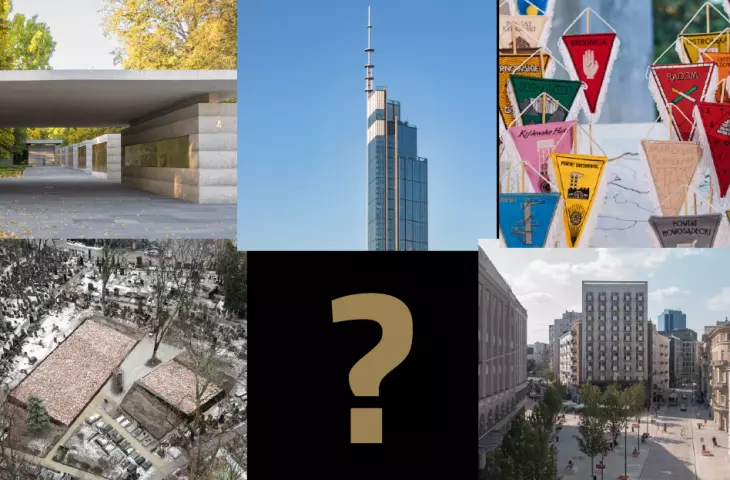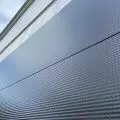The controversial Five Corners Square, a district convention in the capital, rebuilt greenhouses next to a shopping center or the tallest skyscraper in the European Union—these are just some of the nominations in the 9th Edition of the Architecture Award of the President of Warsaw. Voting by residents begins—which nominations can be voted for?
As every year, one of the prizes in the competition is awarded by Varsovians through participation in the Residents' Poll. Voting runs from May 8 to 21. The competition's jury has prepared a list of the 17 best projects and events commissioned or organized in 2022. Candidates were divided into six categories—public architecture, commercial architecture, residential architecture, adaptations, public spaces and events.
The nominations, but also the main prizes, which will be awarded on June 14, were decided by a jury that included representatives and representatives of the city—Deputy Mayor Michał Olszewski, Danuta Kończyk, Ewa Jańczar and Marlena Happach, people associated with the design community—Łukasz Górzyński, Tomasz Majda, Magdalena Federowicz-Boule, Anna Tofiluk, Judyta Wesołowska, and people involved in media and journalism—Ewa P. Porębska, Grzegorz Piątek and Marcin Szczelina.
Below is a list of all the nominees, along with the data and descriptions of the candidates provided by the competition's orgnizer.
public architecture
Chamber of Remembrance at the Warsaw Insurgents Cemetery
photo: Bujnowski Architekci / Warsaw City Hall
Authors: Bujnowski Architects: Piotr Bujnowski, Maciej Koczocik, Krzysztof Makowski, Martyna Rowicka-Michałowska, Katarzyna Magdzik, Paweł Grajda, Aleksander Stajniak, Karina Jędrak-Kościesza
The symbolic commemoration of the victims of the Warsaw Uprising consists of an entrance area, two pavilions, a Wall of Remembrance and a landscaped cemetery setting. The structures are made of architectural concrete. The entrance pavilion with an arcade on Wolska Street tips towards the new establishment and the transverse main composition avenue with the Polegli Niepokonani monument. Plaques with the names of nearly 62,000 identified civilian victims and soldiers of the Warsaw Uprising are mounted on the Memorial Wall. They will be replenished. There is an exhibition in two pavilions with a Chamber of Remembrance, a Hall of Testimonies, and a Hall of History. One can also see, among other things, a film with a message for future generations by Home Army soldier Wanda Traczyk-Stawska, the initiator of this commemoration. The realization was preceded by an architectural competition decided in 2015.
Elementary School No. 403 in Odolany district
Photo: Piotr Krajewski / UM Warszawa
Authors: architect Radosław Guzowski: Radosław Guzowski, Hubert Sałaga, Urszula Trawicka, Eduardo De Sa, Blanka Noyszewska, Aleksandra Przywózka, Agata Kotowska
The modern school consists of several expressive blocks. Two are straight and long, set perpendicular to the street with the main entrance area. There is also a rounded section that repeats the shape of the street arch. The modernity is emphasized by the strip windows on the upper floors. They are like large storefronts. The large rectangular block to the left of the entrance houses the library, gymnasium, fitness room, sanitary facilities and a cafeteria with a kitchen. Classrooms have been grouped in the central part of the block. The part of the building on the right, curved softly into an arch, is the space of a kindergarten kindergarten. The school will eventually organize education in 28 single-shift divisions: including 24 for grades I-VIII for 600 students and four kindergarten ones for 100 children. In addition to these rooms, the educational complex has seven smaller classrooms, there are three language labs, three common rooms, a library, a children's playground and two multipurpose fields. The cost of the investment was PLN 49 million.
Day care center for oncologically ill people and their families
Photo: Piotr Krajewski / UM Warszawa
Authors: Atelier 3 Girtler & Girtler Biuro Architektoniczne, Marta Girtler-Szymborska, Ryszard Girtler
White and austere in form, the building is warmed by fragments of wood facade, including folding shutters. The most important thing is the function. It's a day care home for people battling oncological diseases and their families. The „I AM” Foundation helps cope with the stress of the disease. It supports patients who are in and out of treatment. It organizes talks with a psychologist, rehabilitation, learning healthy nutrition combined with cooking, lectures and workshops, joint trips to the theater and cinema. People accompanying the patients can participate in the activities.—Our foundation is for healing. If someone has cancer they go to the hospital for treatment. What we do in our foundation allows you to better endure cancer treatment and fix your head. We have classes on how to deal with stress before tests or what to do if the doctor is unkind. It helps to bear it all more easily. I'm an oncology patient and I know how much this gives," says „I AM” foundation president and co-founder Izabella Dembinska.
commercial architecture
Forest office building
Photo: HB Reavis
Authors: HRA Architects: Wojciech Hermanowicz, Błażej Hermanowicz, Stanisław Rewski, Paweł Maciążek, Bartosz Michalski, Roman Galiński, Mateusz Jasiński, Magdalena Szucio, Roman Malka, Karol Terlikowski, Łukasz Sumiński, Tomasz Piątek, Marek Jaxa-Chamiec, Robert Ptasiński, Dominika Zając, Baltazar Brukalski
The building, dubbed the Forest office campus, was built at the „Radoslaw” AK Grouping Roundabout. The more than 120-meter-high tower section rises from a podium six to ten stories high. The lump of the tower has faults, its tectonics is emphasized by the finial. The lower part of the building surrounds a public atrium with greenery, water and resting areas. Where the skyscraper's podium slits, there is a wide opening with a plaza that connects the office building's space to the residential area next door. The architects wanted the distinctive colors of the vertical elements to refer symbolically to the trunks and bark of the trees. The main entrance to the building is on the side of the traffic circle, leading through a small park that extends to Burakowska Street. In terms of the size and quality of the green areas on the roof, this is a unique building. Care has been taken with the energy-saving technical equipment of the building or the use of gray water. Open façade elements allow natural ventilation. 500 racks, locker rooms with showers and a repair point await bicycle commuters.
Varso Tower and Varso Place
photo: Piotr Krajewski / UM Warszawa
Authors: Varso Tower: Foster + Partners, Grant Brooker, Krzysztof Górnicki, Jędrzej Kolesiński
Varso Place: HRA Architects: Wojciech Hermanowicz, Błażej Hermanowicz, Stanisław Rewski, Paweł Maciążek, Paweł Adamiak, Zofia Mikołajczak, Joanna Owczarek, Marek Jaxa-Chamiec, Roman Galiński, Baltazar Brukalski, Robert Ptasiński, Monika Wiercioch
The lower part of the Varso Place development consists of Varso 1 and Varso 2 buildings by HRA Architects (70,000 sqm). They were completed in 2020. Two years later, the tallest skyscraper in Warsaw and the European Union was built—Varso Tower by Foster + Partners. It has 53 floors and 310 meters including an 80-meter spire. It serves an office function. The slender tower has two public viewing terraces: at 205 meters (with a restaurant) and 230 meters. Two walls in the lobby more than 10 meters high are decorated with a ceramic mosaic by Krystyna Kaszuba-Waclawek. Greenery is an important part of the project: dozens of trees have been planted in front of the building, on the terraces and in the lobby. The lower part of the Varso Place office and retail complex forms the so-called podium. It has elevations of stone, from which two towers of glass rise. The buildings composed in this way form a new frontage of Chmielna Street with a length of 200 meters. The lower part of the buildings refers in scale to the so-called Warsaw height and pre-war edifices in Jerozolimskie Avenue. The first floors along Chmielna include arcades. The street, redeveloped by the investor, is decorated with carefully designed greenery and small architecture. The investor planted 80 trees. Varso Place's urban planning and architecture have developed the void next to the downtown railroad area.
Mirrored office building on Poleczki
photo: Piotr Krajewski / Warsaw City Hall
Authors: A5 Architects, Magdalena Wroniszewska, Jakub Wroniszewski, Thomas Dryjski, Piotr Waga, Anna Zagorec, Eleonora Quinzi, Otto Kus
The intimate four-story building occupies a triangular plot at the junction of Poleczki and Wyczółki streets in the vicinity of Służewiec Race Track with an avenue of ash trees. The façade clad in panels of polished aluminum blurs the boundary between the architecture and the park-like surroundings. Situating the entrance at the back of the building, rather than on the side of busy Poleczki Street, allows for the comfort of communing with nature in an urbanized landscape. From the intense traffic and urban chaos, the building is set apart by the simple lines of its massive facade with narrow window openings. Service area accessible from the sidewalk level is located on the first floor facing Poleczki Street. The windows provide good daylight. Flexibility of arrangement is provided by the construction grid, division of the facade in 135 cm module. The inflow of light and solar energy is regulated by automatic external blinds. A heat pump is installed in the building.
residential architecture
Brick buildings on Grodno Street
photo: Piotr Krajewski / Warsaw City Hall
Authors: TZA Targońska Zadrożny Architects: Marcin Zadrożny, Aleksandra Targońska, Daniel Małek, Magdalena Zalewska, Dorota Żak, Joanna Hutny
The new red brick development consists of three parts. Three blocks with 108 apartments (areas ranging from 29 to 100 sqm) rise from a one-story plinth with commercial units. Between them is a public courtyard with greenery, seating and bicycle parking. It provides a shortcut for people walking to the subway at Dworzec Wileński or Szwedzka Street. A pedestrian walkway on the side of Kosmowska Street provides a foreground for service establishments separated from the roadway by greenery with a row of trees. The balconies have a characteristic shape. Among other things, they are made of solid colored prefabricated elements and metal balustrades. Depending on the angle of view, the balconies appear light and openwork or heavy and massive. The roofs of the lower sections are green. Above the top section are photovoltaic panels that power the building's common spaces. Above the first floor there are spacious pots with greenery, with climbing plants growing in the gaps between the blocks.
Apartments at Niemcewicza
photo: Piotr Krajewski / Warsaw City Hall
Authors: JEMS Architekci: Olgierd Jagiełło, Paweł Majkusiak, Łukasz Kuciński, Aleksandra Dutkowska, Urszula Kos, Agnieszka Rokicka, Bartosz Śniadowski, Dominik Wroński
The first stage of the Niemcewicza Apartamenty project was completed in 2016. (122 apartments, at No. 16). The second stage at 19 Niemcewicza Street was its continuation and closing of the whole project in 2022 (56 apartments). The new residential houses were built in the vicinity of modernist Ochota buildings from the 1930s. They have six floors above ground and two underground with garages, stone cladding on the facades, deep loggias with glazing on the sides and light woodwork. The new buildings are modern, finished with sandstone panels. They are distinguished by large windows and loggias in a horizontal arrangement. The whole gives the impression of architectural continuity, but also of a new stage in the urban development of the district. The innovative elements do not constitute a dissonance with the buildings of Old Ochota.
new life of buildings
A school for children from Ukraine in the Myhive Mokotow Two office building
Photo: Martyna Rudnicka / UM Warszawa
Authors: XYstudio: Dorota Sibińska, Marta Nowosielska, Filip Domaszczyński, cooperation: Natalia Komsta, Małgorzata Sikora, Marta Skoniecka, Łukasz Smolczewski
In two months it was possible to organize an 11th-grade school with Ukrainian staff for about 200 children.—Among the more than 200 volunteers were a soldier from Peru, female and male students from the Faculty of Architecture at the Warsaw University of Technology, Ukrainian mothers, female CEOs, directors and rank-and-file employees of corporations, as well as individuals who gave us their time, heart and muscle power, says sociologist Magda Garncarek of the Open Schools Association. Immofinanz donated a 1,240-square-meter floor in an office building in Służewiec Przemysłowy (the former Sirius) for the project. Each classroom has a different layout tailored to different age groups and a distinctive color scheme. The walls are decorated with geometric patterns and paintings. There is a common room, there are seating areas with armchairs, poufs and tables. There are two psychological offices where children and caregivers can get help. Many people are struggling with traumas because they had to flee war zones. The facility in the office building is a branch of Materynka, a Ukrainian school that has been operating in Warsaw (and is a branch of the school in Kiev) for several years. It is under the Ukrainian Ministry of Education and Science, and issues certificates.
Modernization of the National Library
Photo: Jakub Certowicz
Authors: Konior Studio: Tomasz Konior, Dominik Koroś, Andrzej Witkowski, Marcin Piotrowski, Wojciech Przywecki, Michał Lipiec, Angelika Drozd, Mikołaj Zdanowski, Piotr Straszak; SOKKA: Katarzyna Sokołowska, Wojciech Sokołowski, Ewelina Bidzińska, Michał Latko, Marcin Maciejewski
It took six years to modernize and expand the National Library's reading room. The project was selected in an architectural competition in 2015. The architects decided that the most important zone was the space at the intersection of the main entrance axis and the reading room axis. The existing courtyard was covered with a glass roof, which is supported by steel columns. Finishing materials include copper, wood and stone. The reception counter marks the boundary between the public area and the reading room area. Its lower and upper sections are connected by a monumental spiral staircase. The whole is complemented by four interior gardens with different styles. After the modernization, the reading rooms of the National Library are three times larger and offer almost 400 seats. There are four times as many books on the shelves with free access to the collection. The facility is accessible to people with disabilities.
Ulrich Gardens
Photo: Bartek Barczyk / WXCA / UM Warszawa
Authors: WXCA: Marta Sękulska-Wrońska, Szczepan Wroński, Monika Lemańska, Jan Kucza-Kuczyński, Mikołaj Niewęgłowski, Adrianna Bańczerowska, Katarzyna Dudek, Michał Krawczyński, Paulina Pernak, Ewelina Szeląg, Andrzej Bulanda
The Wola Park Center stood on the site where, since 1876, the greenhouses and crops of Warsaw's largest horticultural company, C. Ulrich. The farm's owners gave their name to this part of the city. The Ulrich family built the greenhouses in 1878 and cultivated exotic plants and pineapples, among other things. After nationalization after 1945, the horticultural establishment was losing its importance, the greenhouses fell into disrepair. The heirs of the former owners sold the land for the construction of the Wola Park Center. The investor reconstructed the greenhouses using the historic substance. The structures have been overbuilt to about 7 meters. The above-ground parts are connected underground by a brick connector. The details of the white ironwork and glazing supported by the steel structure were reconstructed. The greenhouses house cafes and restaurants, a conservatory, and a children's play space. A plaza with urban furniture and greenery was created.
design of public spaces
Five Corners Square
photo: Bartek Barczyk / WXCA / Warsaw City Hall
Authors: WXCA: Adrianna Bańczerowska, Paweł Grodzicki, Michał Kempiński, Kacper Ludwiczak, Piotr Łosek, Marta Sękulska-Wrońska, Szczepan Wroński
A green and pedestrian-friendly square without barriers and curbs has been created in place of a busy intersection of five streets. It has a surface of large-format architectural concrete slabs. Large field maples grow out of the hard pavement. Underneath it hides infrastructure that protects the trees' roots, provides water supply and air access. Striking lighting in the pavement and light points on poles highlight the new plantings. A small fountain is in operation. Many benches are standing. The architectural competition for the design of the square was preceded by research in environmental psychology and consultations with Warsaw residents and local business owners. The change in traffic organization allowed additional space for the square's most important functions. There is more space for food gardens, benches, and rest areas. The passage from Krucza Street to Szpitalna Street has been preserved for buses. The area of the entire square is now a residential zone.
Commemorating mass graves in the Jewish Cemetery
photo: Karol Dzik / Warsaw City Hall
Authors: Archiworks: Karol Dzik, Maciej Szpalerski, Krzysztof Matuszewski
A memorial to the Jews who died or were murdered on the streets of the Warsaw Ghetto and buried in mass graves has been created at the Jewish Cemetery on Okopowa Street. These are two large quarters in the form of earthen mounds. They are framed in corten steel, falling towards the main axis with a small square. The quarters are covered with thousands of smaller and larger stones. The central space in the square between the quarters is accented by a vertical and openwork structure made of rebar. It is filled with stones. It is one of the largest mass graves in Europe. The work on this commemoration was financed by funds from the Chancellery of the Prime Minister, the Ministry of Culture and National Heritage within the framework of the „Graves and War Cemeteries in the Country” program, as well as the Jewish Religious Community in Warsaw.
Arsenal City Hall sports square
photo: Lukasz Leszczynski / Warsaw City Hall
Authors: WWJA: Wojciech Jakubowski; cooperation: Urban Sports Square, Flowparks
Urban Sports Square was created over the technical space of the subway and the Ratusz Arsenal station as part of the Civic Budget. Now it is an attractive barrier-free space with carefully composed greenery that attracts a variety of users. There are walking paths. There is a strip of concrete for roller sports enthusiasts. For comfort and safety, the walking paths and those for active recreation are separated. The arrangement of the square is complemented by small architecture—pergolas, benches, deck chairs, trash garbage cans and bicycle racks. The new space is muted. An earth embankment overgrown with shrubs and trees was created on the side of Gen. Władysława Andersa Street. The green embankment dampens noise. Twenty-four new trees are growing on it: birch trees and Lamarckian marmots. The square is decorated with several thousand shrubs, perennials and decorative grasses. The walking alleys have mineral-resin surfaces. They are permeable to water. Closer to Krasinski Garden, sets of calisthenics equipment have been erected. In this zone, the surfaces are permeable, safe and non-slip.
architectural events
The exhibition "Natalia Romik. Hideouts. Architecture of Survival"
photo: Daniel Chrobak / UM Warszawa
Authors: Natalia Romik; curators: Stanisław Ruksza, Kuba Szreder; research collaboration: Aleksandra Janus
The exhibition at Zachęta was a summary of Natalia Romik's research project supported by Gerda Henkel Stiftung and The Foundation for the Memory of the Shoah. It presented mirror casts of nine Jewish hiding places from Poland and Ukraine. The exhibition of sculptural forms was accompanied by a presentation of interdisciplinary research by anthropologists, historians, archaeologists and urban explorers. The exhibition was an artistic tribute to survival architecture, the hiding places built and used by Jews during the Holocaust. Among others, tree hollows, closets, city sewers, caves and empty graves served as shelters. Artistically modified models of hiding places became a tribute to the daily hardship of those who were hidden and those who were hiding, their creativity, solidarity and will to live.
Open Housing Festival
photo: Festival of Open Flats / UM Warszawa
Authors: Jerzy Stanisław Tarłowski, Klaudia Anna Obrębska, Maria Tyszkiewicz, Dorota Gołębiewska, Marek Działek, Adrian Sobieszczański, Katarzyna Uchowicz, Beata Chomątowska, Krzysztof Mordyński, Sławomir Gzell, Grzegorz Michalak, Grzegorz Mika, Agnieszka Dankowska, Klaudia Mateuszuk, Barotsz Zacharski, Dominika Czajak, Maciej Gałecki, Michał Murawski, Wojciech Biernacki, Arkadiusz Wójcicki, Nawojka Bauer, Paulina Pakosz
Organizer: Towarzystwo Opieki nad Zabytkami Warsaw Branch
The 10th edition of the Open Housing Festival was held in 2022. The event brings closer the issue of historic preservation and valuable architecture. Participants visit interesting buildings, not only those included in the Municipal Register of Historic Places or the Register of Monuments. Open-air architectural walks are hugely popular. Accompanying lectures are used to deepen knowledge. All of them were organized in the ZODIAK Warsaw Architecture Pavilion. The round edition of the festival summed up a decade of work by the Warsaw Branch of the Society for the Care of Monuments.
The Great District Rally. Conference, seminars, workshops and cinema
photo: Kuba Rodziewicz / NIAiU
Curators in Warsaw: Alicja Gzowska, Zuzanna Mielczarek
Production: Mateusz Włodarek, Artur Wosz, conference program coordinator: Katarzyna Lisowska, communications: Joanna Krupa, Dominik Witaszczyk, visual identity: Wojciech Gawronski, Katarzyna Nestorowicz; artistic refreshments: TURNUS; production support: Robert Godlewski, SOLIDECO company
Organizer: National Institute of Architecture and Urbanism
The three-year project covered 21 former counties. The National Institute of Architecture and Urbanism, with local curators, looked at the architecture of the interwar period in smaller towns. In Poland after 1918, the central government wanted to build a modern state. They invested in industry, education and housing. These achievements were presented in subsequent editions of the project „Infrastructure of Independence: The Architecture of Polish County Modernization Projects.” The exhibition „Greetings from the districts!” provided a summary of local activities carried out in 2020 and 2021. All events were closed by the Great County Rally.


































































